| Construction Rating: | starstarstarstarstar_border |
| Flight Rating: | starstarstarstarstar_border |
| Overall Rating: | starstarstarstarstar_border |
| Manufacturer: | Cosmodrome Rocketry  |
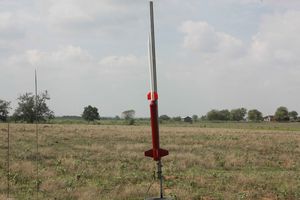
Brief:
Of the Consmodrome line, the 2 that have the most appeal to me are the Vostok and the Nike Apache. The Vostok has
been sitting in my pile almost since the beginning of my return to rocketry intimidating me. The Nike Apache is a
recent acquisition and does not seem nearly so intimidating. I decided to give it a try.
Construction:
Construction started out by locating the 29mm motor tube and running a line down its length. An Estes angle tool was
used to do this. Tick marks were then placed 1/2" from either end along the line.
The kit came with 2 plywood centering rings. I had to locate the one with two notches, as opposed to the single notch ring, and the steel recovery harness. The loop in the steel cable was fitted through the 2 notches in the centering ring and then slipped into place on the motor mount at one of the tick marks. The ring was then epoxied into place.
The other centering ring had only a larger, single notch in it. It was placed at the opposite end of the motor tube with the notch lined up over the line and epoxied into place, making sure that no epoxy obstructed the hole formed by the notch.
The instructions indicated that I was to cut 2 pieces of cardstock, one was a strip 1.5" x 1/8" and the other was 1/2" x 1/8". A piece of threaded rod was then fed through the hole on the centering ring and the tube was marked at the point where 3/4" protruded from the end. It took a while for me to understand the purpose of the strips I had cut. The instructions said to place them between the threaded rod and the motor tube. They did not indicate a purpose or an orientation. After a while, I realized that the longer strip terminated at the mark I had made for the rod and deduced, correctly I hope, that they are just to give a slight angle to the rod which is used for motor retention. I tacked the long strip in place and then the shorter one on top of it. The rod was then inserted to the mark and epoxied into place, taking care not to let epoxy onto the lower threads.
The kit came with 4 plywood fins for the Nike portion of the stack. The instructions said to sand them down to a knife edge on the leading and trailing edges. I marked the centerline, got out a sanding block, sanded a bit and then reconsidered. There has to be a "good" way to do this right. After hearing back from Cosmodrome on TRF, I adopted the manufacturer's recommended practice for sanding in the correct profile to the fins. I applied a wide strip of masking tape along the line I had marked on the side opposite to which I wanted to sand. I then put two more strips of narrower tape right on top of it and did the same to the reverse side. A sanding block was then repeated drawn along the side to be sanded gradually removing material. When the sandpaper had eaten through the top two pieces of tape, the tape was replaced and the process continued. I found that for each surface of each side of each fin, I would have to replace the tape about 4 times in order to achieve the "knife edge". Be advised that I am speaking in terms of butter knives, I was afraid of ruining the fins by sanding anymore. I got 1 fin done per day because it does take time and, frankly, it was not an enjoyable process for me. That being said, it was effective and I have no complaints. I think the result will be worth it.
With three fins done and a fourth one waiting to be done, I stared dejectedly at my dwindling supply of course sandpaper and looked wistfully towards my belt sander. Against my better judgment, I decided to give it a try. I masked off the high areas as before, flipped the switch and hoped that I was not destroying the fin. It actually went easier and slower than I expected with slow being the key word. I was able to give the fin an acceptable profile and avoid a trip to the hardware store.
The last page of the instructions came with a fin marking guide of the type where you set the rocket on the circle and make your marks. I generally prefer the wraparound type but don't knock any points for this type. This is especially with so since, for me, the butt types are not as difficult to use with the larger tubes. It also helps with both types when the sizes are dead on and this one was.
 The Nike body tube was placed on the template and the lines for the 4 fins and the lug were
transferred. An angle was then used to lengthen the lines with the lug line running the length of the tube. Each of the
fin lines was marked a specified distance from the back of the tube; I think it was an inch but I do not remember. The
fins were numbered in pencil with the characters for one through four since I was not certain that they were strictly
interchangeable in terms of the sanded profiles. The fin lines were also so marked. The root edges of the fins were
then aligned with their respective fin lines having their rear edges along the previously mentioned marks and were then
held in place as a pencil was used to draw their outlines. A razor knife was then used to cut out the marked lines and
allow the fins to slide in.
The Nike body tube was placed on the template and the lines for the 4 fins and the lug were
transferred. An angle was then used to lengthen the lines with the lug line running the length of the tube. Each of the
fin lines was marked a specified distance from the back of the tube; I think it was an inch but I do not remember. The
fins were numbered in pencil with the characters for one through four since I was not certain that they were strictly
interchangeable in terms of the sanded profiles. The fin lines were also so marked. The root edges of the fins were
then aligned with their respective fin lines having their rear edges along the previously mentioned marks and were then
held in place as a pencil was used to draw their outlines. A razor knife was then used to cut out the marked lines and
allow the fins to slide in.
The next step was to wrap the rear of the body tube with Saran Wrap. This is to protect it from the moisture that is soon to come. When the wrap was in place, I retrieved the provided piece of cardstock and spritzed with water from a spay bottle I swiped from you-know-who's laundry department. The purpose of this is to allow the cardstock to more easily conform to the body. I wrapped the stock around the body and tied it into place to dry with some surplus shroud line. The tube and wrap were then set aside to dry. A day later, I removed the string holding the wrap in place and, sure enough, it had been re-molded into approximately the curvature of the Nike body tube. I did a little trimming with a razor knife to remove a tiny bit of material from one end to make a tight closure and then used some sandpaper to fair up the edge.
Some slow cure epoxy (30 minute) was mixed because I perceive it to be a thinner fluid and was then brushed onto the inside of the wrap. The wrap was slid into place flush with the aft end of the BT and with the seam along the launch lug line. Some masking tape was used to hold it in place as it dried.
I worked on some other things and about an hour later removed the tape. The next task was to duplicate the fin slots from the BT on the wrap. After several trial and error attempts, I decided that the easiest thing to do was to make a slit down the center and then shave away from the outside while peering down the interior of the tube. I kept whittling away until I test fit each of the numbered fins successfully.
A long swab was used to make a ring of epoxy around the interior of the BT just forward of the fin slots and the motor mount was shoved part way in. When the forward ring was in, I paused and swabbed another ring of epoxy around the after end. The mount was then pushed into place with the retaining bolt aligned with the seam on the lower wrap and the rear centering ring flush with the end of the tube. The tube was set upright for a while so the epoxy would flow back towards the rings as it set. After 10 minutes, I mixed some more epoxy and brushed it around the seam on the after ring and put it aside to set up.
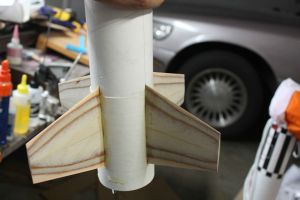 Next, I skipped ahead a few steps and pulled out the Apache fins. These again were made of
plywood and again needed to have a profile added. I marked off an 1/8 inch on each leading edge, drew a line and then
marked the line with a strip of masking tape. Since I had developed a little confidence with the best sander on the
last of the Nike fins, I decided to use it for the Apache fins as well. I took it slow and, while the bevels are not
perfect, they are good by my own admittedly marginal standards.
Next, I skipped ahead a few steps and pulled out the Apache fins. These again were made of
plywood and again needed to have a profile added. I marked off an 1/8 inch on each leading edge, drew a line and then
marked the line with a strip of masking tape. Since I had developed a little confidence with the best sander on the
last of the Nike fins, I decided to use it for the Apache fins as well. I took it slow and, while the bevels are not
perfect, they are good by my own admittedly marginal standards.
The first of the Nike fins to be installed was number 4. I test fit it once again and then applied some epoxy to the root edge. The fin was slipped into its slot and pressed into place checking for straightness. A bit of epoxy was the filleted along each side of the BT with my finger and allowed to set up.
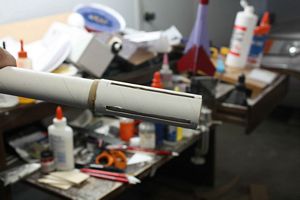
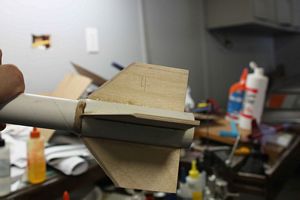
Fin number 3 was installed just as number 4 was except the slot was a bit looser and I needed some tape to hold things in place as the epoxy cured. Further fin installation was interrupted by work concerns and I set things aside to dry for the night.
When I got back to the Nike Apache, the last two fins were installed like the first two without any problems.
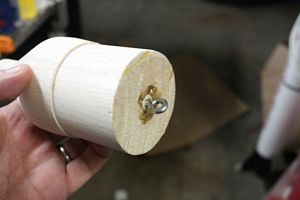 One of the things that I liked about this kit was the way the screw eye is mounted to the
transition. A natural worry with any rocket, especially a heavier one, is the screw stripping out at ejection even when
reinforced by epoxy. This kit goes a long way in lessening that worry with its approach. The screw eye was screwed into
a plastic anchor screw with large, aggressive threads and then backed out. A drop of epoxy was put into the hole of the
anchor and the screw eye re-inserted. The process was then repeated and the anchor was screwed into the balsa
transition, backed out, the hole filled with epoxy, and re-inserted. Epoxy was used to fill around the screw as well.
On the opposite end of the transition, a piece of wooden dowel was epoxied into the cavity to strengthen a potential
failure point.
One of the things that I liked about this kit was the way the screw eye is mounted to the
transition. A natural worry with any rocket, especially a heavier one, is the screw stripping out at ejection even when
reinforced by epoxy. This kit goes a long way in lessening that worry with its approach. The screw eye was screwed into
a plastic anchor screw with large, aggressive threads and then backed out. A drop of epoxy was put into the hole of the
anchor and the screw eye re-inserted. The process was then repeated and the anchor was screwed into the balsa
transition, backed out, the hole filled with epoxy, and re-inserted. Epoxy was used to fill around the screw as well.
On the opposite end of the transition, a piece of wooden dowel was epoxied into the cavity to strengthen a potential
failure point.
The base of the Apache portion of the rocket is a built up affair and I have to admit that I almost ruined it. The kit came with a short length of 29mm motor tube which serves as the base and what amounts to a 29mm thrust ring. There was also a coupler tube to fit within the motor tube. The first thing I was instructed to do was to mark the longer of the two interior tubes at 1/4" and then epoxy it into one end of the motor tube leaving 1/4" hanging out. This was easily done but the coupler would not fit into the motor tube so I had to sand it down some, removing my marks. It was easily marked again and then I decided to use white glue instead of epoxy. It was tight and I did not think it was a realistic failure point.
The next step was simple enough. The thrust ring was glued in place at the opposite end of the motor tube. Again, white glue was used. The interior joints at both ends were then filleted with white glue and it was set aside to dry for a short while.
I took a look at the Apache nose cone while the base assembly was setting up. It was reasonably clear balsa with just a touch of roughness on one side. I decided to harden it some by dousing it with some thin CA.
This next part is where things became dicey because I misunderstood the instructions. The instructions were correct but I was letting a single word cause me to misinterpret them and even ignore (subconsciously) other verbiage that should have set me straight. I was supposed to sand a bevel into the portion of the coupler tube that extended from the motor mount. It was supposed to transition from its natural diameter to the diameter of the main Apache tube. Essentially, it was to taper to 0". That part I got and most of the tapering was done with a sanding stick. It was the next instruction that got me. I interpreted it to mean that the Apache tube would be butted up against the freshly tapered coupler and epoxied into place with a simple butt joint resting upon a "surface" that had just been sanded from a surface into an edge. I just knew it was going to be the primary failure mode of each and every flight if the rocket even made it to the field without breaking at that point. I was already considering rolling my own coupler to fit into both the original coupler tube and the body tube so that I would have more gluing surface and something to try and hold things straight. As stupid as this sounds, I was convinced that was what I was supposed to do. Thankfully, an uncommon bout of sense had me read the instructions again and the word that had thrown me was thrown up in relief.
The aft end of the apache tube was to be butted even with the aft end of the base.
"Butt" had mislead me into ignoring the stupidity I was displaying. The Apache tube fit through the sanded coupler, through the motor mount, and through the thrust ring. It should have plenty of support. I again used white glue instead of epoxy.
With the Apache tube secured in the Apache base, I moved the base over to the fin marking guide for the Apache and transferred the marks. Doing it with the smaller tube made me wish again for the wraparound type but the job got done. An Estes angle tool was used to run the 4 lines the length of the base and one of the lines was run the length of the entire Apache tube. Each of the lines was marked off 1/4" from the aft end and then the fins and lines were numbered in the same manner as the Nike fins and slots were cut.
Mounting of the Apache fins was for some reason more difficult than the mounting of the Nike fins. This is not to say that it was really hard, they just did not go as easily. The first fin was re-checked to make sure it fit and then epoxy was placed in the slot and along the root edge. The fin was then pressed into place and held with tape. The second fin also went on without any problem. The third fin was where it stopped going so well. It mounted easy enough and I kept eyeballing alignment and finally realized that the 1st and 3rd did not line up as well as they should. I don't blame anybody for that except me but it is a reason I prefer the wraparound guides to the butt end ones. Fortunately, the final fin was OK. All were filleted with epoxy.
You may recall that early on in the building of the motor mount, the instructions called for the use of some cardstock to wedge between the retaining screw and the tube. I recalled it as well as I got the next step and realized that I had cut the strips from the wrong piece of cardstock. The piece I had cut was supposed to be used as the forward wrap on the Apache. Fortunately, the wrap was a little bit big and needed to be cut down a bit. That helped somewhat but there would still be an ugly gap in one part of the seam. It was something that I would have to fix with filler later on.
I wrapped the forward part of the Apache tube with Saran Wrap to protect it from moisture and the sprayed the Apache wrap with water to make it more pliable. It was placed around the tube, tied into place, and allowed to dry out overnight. The next day it had taken on its new shape. Epoxy was then brushed onto the inner surface of the wrap and it was applied to the forward end of the Apache. I tried to line the seam up with the long line which had been run the length of the tube, however, I must have let it shift without noticing while getting things aligned. The wrap was held in place with tape as the epoxy set up.
The wrapped, forward end of the Apache was pressed against the tube marking guide and the lines were transferred. A mark was then made on each of the lines a specified distance from the forward end. If my memory serves, each was 5-13/64". These marks were to locate the penetrations for the antennae.
The penetrations were supposed to be made with a drill. To my horror, I realized that I had left my drill elsewhere doing some actual maintenance to the house and that I was probably going to have to wait to work further. Thinking about it though, the bit I needed was small and the materials to be drilled through were not tough. On a lark, I tried just twirling the bit between my fingers. It worked!
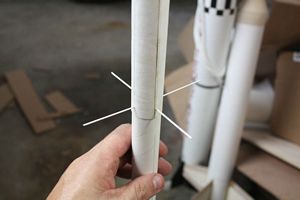 Surprisingly, the next step was one of the toughest for me. The antennae are formed by a
pair of styrene rods Each is to be pushed through a pair of opposing hole. Getting the rods through the first hole was
easy. Getting it through the hole on the other side required a commodity of which I am chronically in short supply:
patience. Then getting the one through orthogonal to the first is even tougher since the holes are at the same level. I
never would have thought I could get them that exact. When the two rods were in place, I made sure that the same amount
stuck out in each instance and then used some epoxy to fix them into place within the tube.
Surprisingly, the next step was one of the toughest for me. The antennae are formed by a
pair of styrene rods Each is to be pushed through a pair of opposing hole. Getting the rods through the first hole was
easy. Getting it through the hole on the other side required a commodity of which I am chronically in short supply:
patience. Then getting the one through orthogonal to the first is even tougher since the holes are at the same level. I
never would have thought I could get them that exact. When the two rods were in place, I made sure that the same amount
stuck out in each instance and then used some epoxy to fix them into place within the tube.
The kit comes with a hefty lead slug to be used as nose weight and move the CG forward. Installation of the slug was simple. Some epoxy was slathered around the top of the Apache tube and the slug inserted. More epoxy was slathered on the top of the slug and then the Apache nose cone was seated. The entire Apache assembly was then inverted to allow things to set up in place.
The basis of the shock cord system is the steel cable already installed. To this is added a long piece of bungee-like cord. It was bent to the steel cable with a double sheet bend. At the opposite end, a loop was tied about a foot back from the bitter end. The bitter end was then tied to the eye screw in the transition.
For the final step of the assembly, the Apache base was glued to the transition. Although the instructions called for epoxy, I used white glue since this did not seem to be a major failure point to me.
Finishing:
The first step in finishing this beast was to mix up some Elmer's Wood Filler and start filling in the imperfections.
These included the grain on the fins, on the balsa, and the seams on the wraps. I put it on rather thick and gave it
about a week to dry completely. Then the laborious sanding process began.
The nosecone and Apache wrap were not too bad. The wrap still needed some more work but the fairing was better than it had been. The Apache fins and transition were a bit more work to sand. It was not difficult but it was tedious. The appearance was definitely improved but there were still some pits in the transition that I was not happy with. Likewise, the Nike fins and wrap were not difficult to sand, just tedious. I used a file and sanding stick to get right up next to the wrap. That helped but there were still some pits to take care of on the wrap seam.
For the next round of filling, I decided to try some Squadron green putty instead. The seam of the Apache wrap got a layer along its entire length but the cone needed nothing more. The Apache fins also needed nothing else but putty was used to fill the pits on the transition. Finally, the Nike wrap seam got a stream of putty as well and the Nike fins needed none. After a day to dry, I attacked the putty with the sandpaper. It took care of the pits in the transition and nothing further was needed there. The wrap seams on both the Apache and the Nike were another story and needed a bit more. I went back to the Elmer's Wood Filler this time, and after it had been dried and sanded, I was satisfied enough to go on.
After dusting everything off, the Nike Apache was taken to the booth to begin the priming process. I started out by spraying 2 sides with Kilz. A day later, the rocket was rotated and I sprayed the other two sides. The Kilz dried for a couple of days and then I took a closer look. The rocket had developed a bad case of the "fuzzies" especially where the wraps had gotten sanded while removing the filler material. I took it back to the bench and sanded it smooth.
After dusting things off, it was back to the booth where the real painting began. On examining the directions, I saw that the body of the Nike was supposed to be white. This was in accordance with my "memory" of the Nike series. With that in mind, I went ahead and sprayed on a layer of white. What I had a question about, though, was the coloration of the Nike fins. I had imagined the normal fluorescent scheme but they were not mentioned in the instructions. The black and white photos I had seen were unclear on the matter and, for some reason, I thought that this rocket would be different. So it is that I sent a message to Cosmodrome asking and he got back to me quickly. It wasn't the answer I expected though. He told me the matter was unclear and sent me some links. Some versions did indeed have the fluorescent red fins. The one that captured my interest though, had a dark red Nike body and fins. I altered my plans then and there. It also had red Apache fins but of a possible florescent cast. That's what I decided to try and do. The photo I liked can be seen here.
When the white had dried, I took the rocket back out and found that I had the "fuzzies" again, although not as badly in the same places as before. A little sanding took care of that and I began to mask off the upper body above the transition to protect it from the red I was going to use. I chose "garnet red" from Rustoleum for the Nike section. The rocket was set in the booth and given 3 coats. The next day the masking was removed and I liked the result. The Nike section was then masked off and the rocket was taken back to the booth. Two coats of white were applied. Examination showed that the same fuzzies that had afflicted the Nike had done so to the Apache as well, but to a lesser degree. They were sanded down with #400 sandpaper. The rocket was then taken back to the booth for another coat of white.
The rocket sat with the white drying for a few days as I attended to other issues and then the masking tape was gotten out to cover everything around the base of the Apache except for the fins. It was then back to the booth again where fluorescent red was applied in very light coats building up to give the red color. The photos make it look much more red than it does in person. A few days later the masking came off. You can definitely see the difference between the reds but its not unpleasing. I was also thrilled that there were no runs.
With the painting done, I could turn my attention to the last item of construction: the launch lug. The kit came with a pair of tubular 1/4" lugs. I made the decision early on that I wanted to substitute a linear rail lug so the originals were not put in place. The linear lug would need, however, a spacer to clear the transition, just like the tubular lugs would have needed. I traced the outline of the lug on a scrap of balsa and then used a razor knife to cut it out. I then held the balsa spacer against the lug and used sandpaper to make the outline conform better.
The location on the Nike BT chosen for the lug had some of the paint scraped away and then a hole was punched through it to make for a better epoxy bond. A few drops of 15 minute epoxy were then mixed and spread on the back of the spacer and the spacer was set in place on the BT. The spacer was then clamped into place. A couple of days later I had a chance to take the clamps off. The rail lug was then set on top of the spacer and the screws were used to mark the balsa. The lug was then removed and the screws were turned through the balsa and the BT and then removed. Some epoxy was then mixed and brushed onto the back of the lug and poked into the screw holes. The lug was then set in place and the screws driven in.
The decal work is seemingly simple on this one. There are 2 "United States" strips of text. They are mounted on opposite sides of the Nike with one having the text run up and the other run down. These turned out to be stickers instead of decals but the quality was good. I peeled the back off, set them in place and then burnished them. The instructions made mention of one more decal that went on the Apache stage. I have no idea what it is supposed to look like because I cannot find it. Let me hasten to add that this might be my fault and that of my chaotic work area.
At this point I thought I was done but as I was looking things over, I chanced to look into the body tube and saw a problem. The screws from the mounting of the rail lug were poking through quite a ways. It was an invitation to rip any chute that got packed in this rocket. I started to remedy this problem by taking a file to it and worrying down the points. This went slowly and then I had a better idea. I took a scrap of balsa and pressed it down over the screw on the inside of the tube. This took up some room. I then mixed some epoxy and used it to hold the balsa in place and round and smooth off what was left of the protruding screws. My reasoning was that the epoxy would help to hold the screws it better and give a non-ripping surface over which the chute could move past.
Construction Rating: 4 out of 5
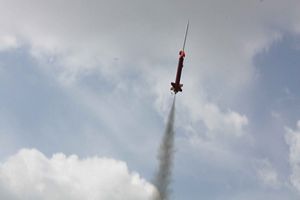
Flight and Recovery:
The day of the maiden flight of my Nike Apache found me ready to go and the others in attendance eager to see how it
performed. I loaded it with a Roadrunner F60-4 and took it out to the pad. There it sat for a while as some low powered
launches took place and I awaited my turn. Liftoff, when it came, surprised me. I did not expect this rocket to move as
fast as it did but move it most certainly did. It was more like launching a light LPR. The climb up was a good one. It
was straight, did not wobble at all, and looked quite impressive. The motor selection seemed to have been a good one.
When the pop of ejection came, the rocket could just barely be seen. We all saw the laundry come out and then we all
saw that there was a problem.
The chute was out but never really opened. I was "treated" to a terrible sight. The Apache portion of the rocket was doing its best imitation of a lawn dart. It was struggling to aerodynamically make its way back to earth as quickly as possible. It was constrained in this endeavor by three things: 1) I'm sure the unopened chute contributed a small but real amount of drag; 2) the Nike booster was acting like a streamer in its own right and trying to impede its own impending doom; and 3) I'm am sure that the sound waves from my plaintive cries from the ground slowed it a little bit as well. All of this was to no avail as it plunged downward. A video of this sad event can be seen here.
An examination of the rocket, when I stopped crying, showed that the damage was not as bad as I had feared. The fins of the Nike booster need to be reset and filleted but the entire booster is in pretty good shape. Even the Apache came out better than expected. The nose cone snapped but it is something that is easily replaced. A member of my club offered to turn a cone out of PVC for me and I accepted his offer in the hope that it will be a bit more durable.
Flight Rating: 4 out of 5
Summary:
I was impressed by several things about this kit. It went together fairly easy for a scale project. It looked good
and it performed great. The blunders that occurred in construction were due to my own inattention to the instructions.
It looked great going up and even kind of cool coming down. I think that the nose cone is a bit tender and that the
instructions could use a slight upgrade, but the former is a property of the material and Cosmodrome has informed me
that the latter will be addressed. Its a great kit.
Persons wishing to follow the exploits of this rockets can do so here.
Overall Rating: 4 out of 5
![[NAR]](/images/archive/images/link_nartitle.gif)
![[Sport Rocketry]](/images/archive/images/link_sr_logo.gif)
The following excerpt is from "Sport Rocketry". The intention is to allow guests to get a basic feeling about a kit. We strongly suggest that you get a copy of the referenced Sport Rocketry and read the entire article. Inside you will find many helpful hints in construction as well as other useful information. For more information, use the two links above.
(Sport Rocketry - May/June 2000 - page 41 - by Mark Sinicki)
![[Courtesy of Cosmodrome]](/images/archive/images2/rp_cos_nike_apache.jpg) "The
Cosmodrome 1:6-scale Nike-Apache is one beefy kit . . ."
"The
Cosmodrome 1:6-scale Nike-Apache is one beefy kit . . ."
"Thick-wall tubing, plywood fins and bulkheads, and a stainless steel
shock cord anchor cable . . ."
"Expect to spend a lot of time on step 4 . . . fins get sanded to a
diamond cross-section."
"The nose cone is a long, narrow balsa affair with space in the bottom for
a large lead nose weight."
"Through-the-wall fin attachment . . ."
"Fin placement templates are provided for both stages."
"Plastruct-type wires are provided to simulate antennas on the upper
stage."
"Applying the self-adhesive decals was no trouble at all."
"The kit was supplied with a 28" purple parachute."
"I found the quick link provided in the kit to be very helpful . . ."
"The model made its maiden flight . . . on an AeroTech F50-6FWL . .
."
"The bird landed on soft, sandy ground, but the leading 1-1/2" of the
balsa nose cone was still splintered upon impact."
The entire article gives the impression that this is a nice kit to experience more detailed and challenging building.
Other Reviews
- Cosmodrome Rocketry Nike Apache By David Sindel (August 27, 2009)
Brief: This is a very nice 1:6 scale model of the Nike-Apache sounding rocket suitable for E motors up through small HPR motors. It's a hefty and strong kit capable of surviving almost anything you throw at. This was my L1 cert rocket. Construction: The parts list: Conical balsa nose cone, 6" long and 1" in diameter. 5oz lead nose weight, 1" long and ...
- Cosmodrome Rocketry Nike Apache By Nick Hills
Brief I have always liked scale kits, so I decided to try the Nike Apache kit from Cosmodrome Rocketry. I made a great choice. As the kit is real nice, and high quality parts used through out. Construction Upon opening of package, every thing was there all in one piece. The balsa transition and nose cone are awesome. They are done real well! You do want to fill any minor dents in ...
 |
 |
Flights
 |
 |
Sponsored Ads
 |
 |












C.S. (November 1, 2000)